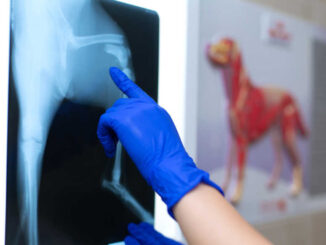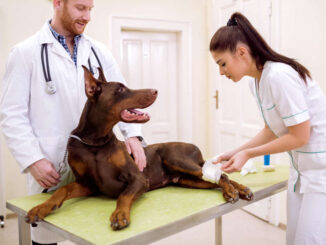
Pet parents often encounter a variety of health issues with their dogs, and among them, paw licking and limping are common. Both warrant veterinary attention and can be caused by minor issues or more problematic underlying diseases. When they occur together, it may indicate the presence of a paw injury, infection, mass, or pain. Let’s explore what might be going on if your dog is limping and licking their paws.
Why is my dog limping & licking their paws?
Dogs can limp for a variety of reasons, ranging from minor to serious health concerns. Possible causes of limping include:
- Injury – Acute injuries, such as muscle strains, sprains, or fractures, can cause limping. These may result from accidents, falls, or rough play. Another common injury is a torn cranial cruciate ligament.
- Joint issues – Joint problems such as arthritis, hip dysplasia, elbow dysplasia, and luxating patella are other common causes of limping, and often worsen with age.
- Neurological issues – Limping can also be a sign of a neurological issue, such as intervertebral disc disease.
- Infection, inflammation, or cancer – Systemic infection, such as Lyme disease, or localized infections in the paw or joints can also cause limping among other clinical signs.
But what could cause a dog to limp AND lick at their paw?
- Foreign object – A foreign object, such as a splinter or plant material, can become lodged in a dog’s paw, leading to discomfort and limping.
- Paw injury – Cuts, abrasions, burns, and torn nails
- Paw pad infection – Pododermatitis is an infection of the paws and often occurs secondary to allergies.
- Mass or growth – A growth, cyst, or mass may be associated with the nails, interdigital spaces, or paws. These may be cancerous or benign.
- Paw pain – A dog may also lick an area that is painful, for example, due to a fracture, arthritis, or soft tissue injury.
- Anxiety or stress – This can lead to excessive licking and secondary infection.
It is common for dogs with allergies to chew and lick at their paws, as well as elsewhere on their body. In severe cases, this may lead to limping. Other signs of allergies include itchy skin, salivary staining (brown discoloration to fur), redness, inflammation, discharge, bleeding, pimples, scabbing, and other recurrent skin and ear infections. Dogs may be allergic to fleas, something in their diet (food allergy), or something in the environment (atopy). If this sounds like your dog, see our article Why Is My Dog Constantly Licking His Paws? Veterinarian Advice.
How to figure out the cause of your dog’s limping and paw licking
While some minor causes of limping and paw licking may resolve on their own, many will require veterinary treatments. Here’s how your vet may approach the issue:
- Physical exam – Your vet will perform a nose-to-tail physical exam and watch your dog walk. They will pay special attention to your dog’s paws and limbs to look for injury, growths, or infections, as well as check the rest of their skin for signs of allergies or irritation.
- Orthopedic exam – This is a detailed exam focusing on the bones, joints, and muscles. Your vet will want to make sure there are no other factors contributing to your dog’s limp.
- X-rays – X-rays are the best way to evaluate for bony injuries or changes associated with arthritis. While swelling may be noted on an x-ray, many soft tissue injuries will not be visible.
- Cytology or culture – If your dog’s paw appears infected, your vet may take a small sample from the skin to evaluate under the microscope. This can help them determine if infection is present, and if it is caused by yeast, bacteria, or both. A culture can be used to definitively diagnose the cause of infection and determine which medications it will respond to.
- Bloodwork – In some cases, your vet may recommend bloodwork to evaluate overall health and organ function, look for evidence of systemic disease, and make sure that your dog is a good candidate for surgery if needed.
- Biopsy of a mass or growth – To determine what it is and if it is cancerous or benign.
Veterinary treatments for limping and paw licking
Treatment recommendations will vary greatly depending on the underlying cause but may include:
- Topical soaks, wipes, or ointments containing antibiotics, anti-inflammatories, and anti-fungals for mild infections
- Antibiotics, pain medications, and anti-inflammatories for infections, wounds, and broken nails
- Pain medications and anti-inflammatories for arthritis
- In some cases, surgery may be needed to repair a wound or remove a mass
- Management of underlying allergies with diet change or medications
- An E-collar to prevent licking while the area heals
First aid for a dog who suddenly starts to limp
If you notice your dog suddenly limping and licking at their paw, you can take the following steps:
- If your dog will allow it, examine the area for any cuts, foreign objects, broken nails, signs of pain, and other abnormalities.
- If you find a foreign object or minor wound, you can attempt to remove it and gently clean the area with mild soap and water. If your dog is painful or sensitive about having their feet touched, it will be best to have this done by your vet.
- Put an E-collar on your dog to stop them from licking at the area, which can lead to additional infection and prevent healing.
- Confine and rest your dog
- Contact your vet
When is it time to see your veterinarian?
If you are concerned about your dog’s limping and paw licking, it is best to schedule an appointment with your vet to determine and treat the underlying cause. Minor issues may resolve without treatment, however, if your dog has a mass, injury, infection, allergies, pain, or is not improving, they will require veterinary care.
Related posts:
Disclaimer: This website's content is not a substitute for veterinary care. Always consult with your veterinarian for healthcare decisions. Read More.








Be the first to comment